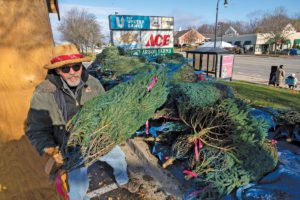When Flatsnoots’ vintage 1951 Vagabond Airstream trailer pulled into the Arbor Farms parking lot on November 9, it announced to passersby and longtime customers that the holiday season was beginning.
“You see Christmas displays in stores on October 1, so people have tree-shopping on their minds long before Thanksgiving,” says Wagatha. “I used to set up the day after Thanksgiving, but these days I’m coming a lot sooner.” He spent four days erecting his tree stands before the evergreen express arrived.

“I used to raise and cut my own trees and then help cut my neighbors’ trees,” Wagatha says, “but my neighbors and I finally realized that they are better tree growers than I am, and I’m a better salesman than they are.” | Photo: Mark Bialek
Vans and semitrucks have already delivered evergreens in all sizes and shapes (trees, wreaths, centerpieces, and roping) to tree lots all over town, and more are on their way. Each tree represents years, sometimes decades, of labor by nearby tree farmers and others as far as half a continent away. Then, tree harvesters swing axes and chainsaws from daylight to darkness and then load their harvest onto trucks.
“This is my thirty-sixth year here,” Wagatha, seventy-two, says proudly. “I come from a small town in the Manistee River valley by the name of Mesick, where everyone raises trees. I used to raise and cut my own trees and then help cut my neighbors’ trees, but my neighbors and I finally realized that they are better tree growers than I am, and I’m a better salesman than they are.”
So, four farmers in Mesick provide Wagatha with nine different native tree species—“but nowadays seventy percent of my sales are Fraser firs,” he says.
Why do Wagatha and his neighbors travel more than 200 miles to sell their trees? “I used to hang out in Ann Arbor in the Sixties, and I loved everything about the place: the people, the laid-back atmosphere,” he says. “So when I had the chance to choose where to go, it was an easy decision.”
Surrounding his vintage Airstream is a forest of trees from three to fifteen feet tall, and other evergreens in pots. Two thousand trees are looking for homes.
“A few times, I’ve called my neighbors, asking for another shipment,” he says. “A few times my neighbors came down to see me in action, but they’ve been cutting trees since mid-October. By the time they send the trucks on their way, they’re ready to collapse and think about something other than trees.”
English Gardens gets trees from Dutchman Tree Farm in Mantin, only a few miles from Mesick. Manager John Darin says they got their first shipment—429 trees—in mid-November, quickly followed by another 740. By the beginning of December, the full order—1,500 trees—will be accounted for. Fraser firs are the most popular, balsams come a close second, and Douglas firs rank third. But the store also brings in the trendy concolor firs (“they have longer needles that smell like citrus”) and a few dozen Scotch pines for customers who’ve been buying them from the Maple Village store since it was Frank’s Nursery.
Kelly Vore, owner of Downtown Home & Garden, waits until Thanksgiving week for her order of 400 trees, which she buys wholesale from the Produce Station. Based on customers’ preferences, she offers the ever-popular Fraser (“grown in Michigan, these account for sixty percent of our sales”) and two varieties raised high in the Cascade Range of the Pacific Northwest: “People really like Nordmann and noble firs for their soft and very lush branches; beautiful color; tall, narrow shape; and fragrance.”
Vore says December 10 is Downtown Home & Garden’s peak tree-sniffing and tree-shopping day. “This is Ann Arbor! Immediately after Thanksgiving, everyone is focused on the Michigan–Ohio State football game. That impacts everyone’s approachability and mood. We’ve found that people here are ready to turn their thoughts to trees two weekends after Thanksgiving.”
The Produce Station carries the same three varieties—1,000 of them. “We like Fraser firs the best because they last the longest, and we really like their look,” Andrew Gorsuch says. “People love old-time varieties, like Scotch pine and balsam, but their needles tend to fall off quickly.”
Darin, at English Gardens, says that along with the rising popularity of Frasers, he’s seeing fewer customers requesting artificial trees. “As the younger
generation is starting to settle down and buy homes, they want real, fresh-cut trees, something alive in their homes during the holidays,” he says. “We also sell artificial trees, but not as many.”
However, the most significant trend this year is higher prices—by as much as 20 percent.
“The reason actually goes back to the recession of 2008,” says Darin. “With the severe economic downturn, farmers stopped planting Frasers—the most popular tree at the time—because those seedlings were more expensive and Frasers take longer to grow. They planted balsams instead. Now the trees are tall enough for cutting, but we won’t have as many Frasers now as previous years. And that’s not the only factor. Since Covid began, we’re paying drivers a lot more than we used to—in 2020, we couldn’t even get drivers until after Thanksgiving—and that is added to the jump in the price of gas.”
Neither the Produce Station nor Downtown Home & Garden had fixed their pricing by press time, but English Gardens’ 1,500 trees range from $48 for a six-foot balsam to $625 for a fourteen-foot Fraser.
“People are still getting a good product at a fair price,” Wagatha says.
“I know how hard the farmers and cutters work, and I know how much gas costs.”